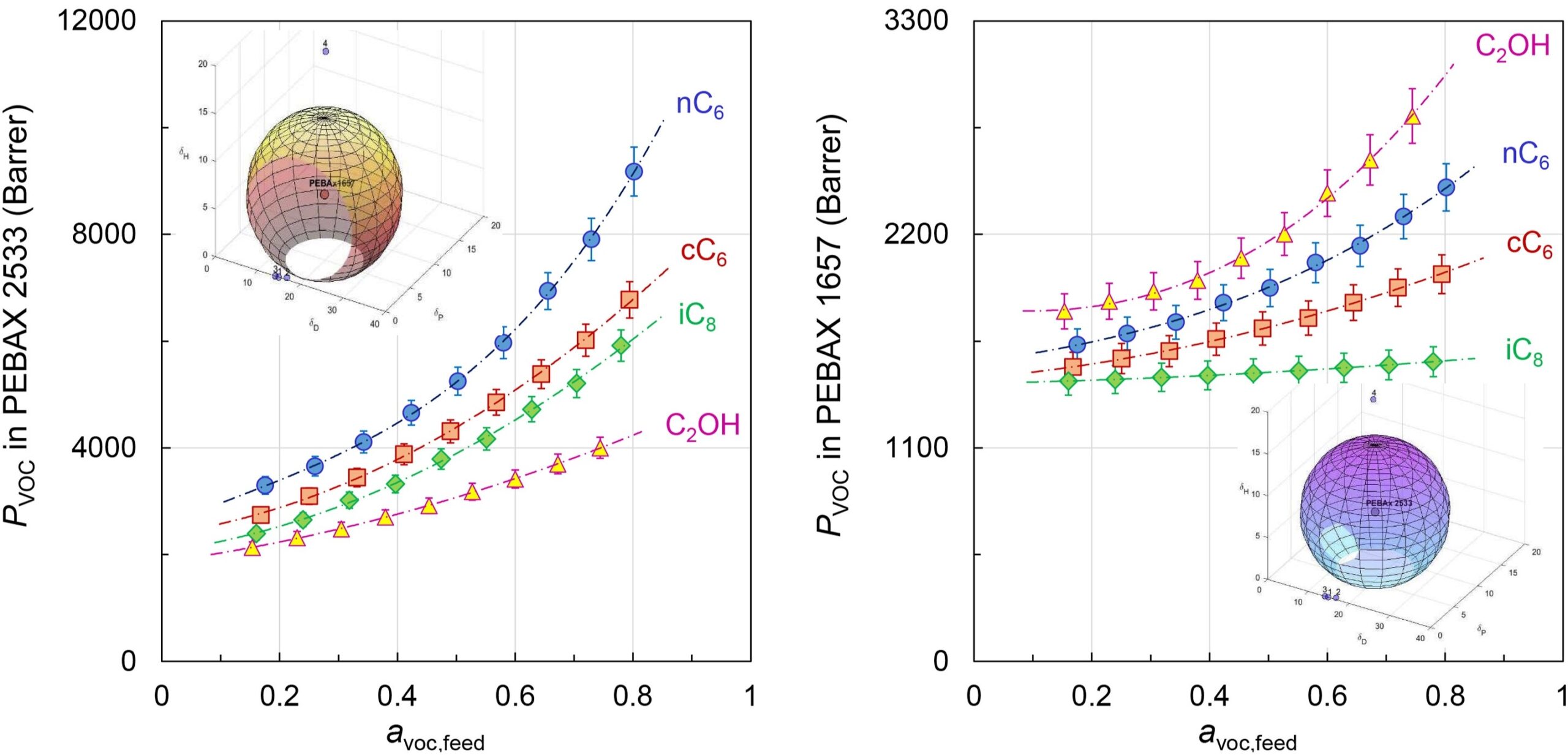Separation of gaseous mixtures
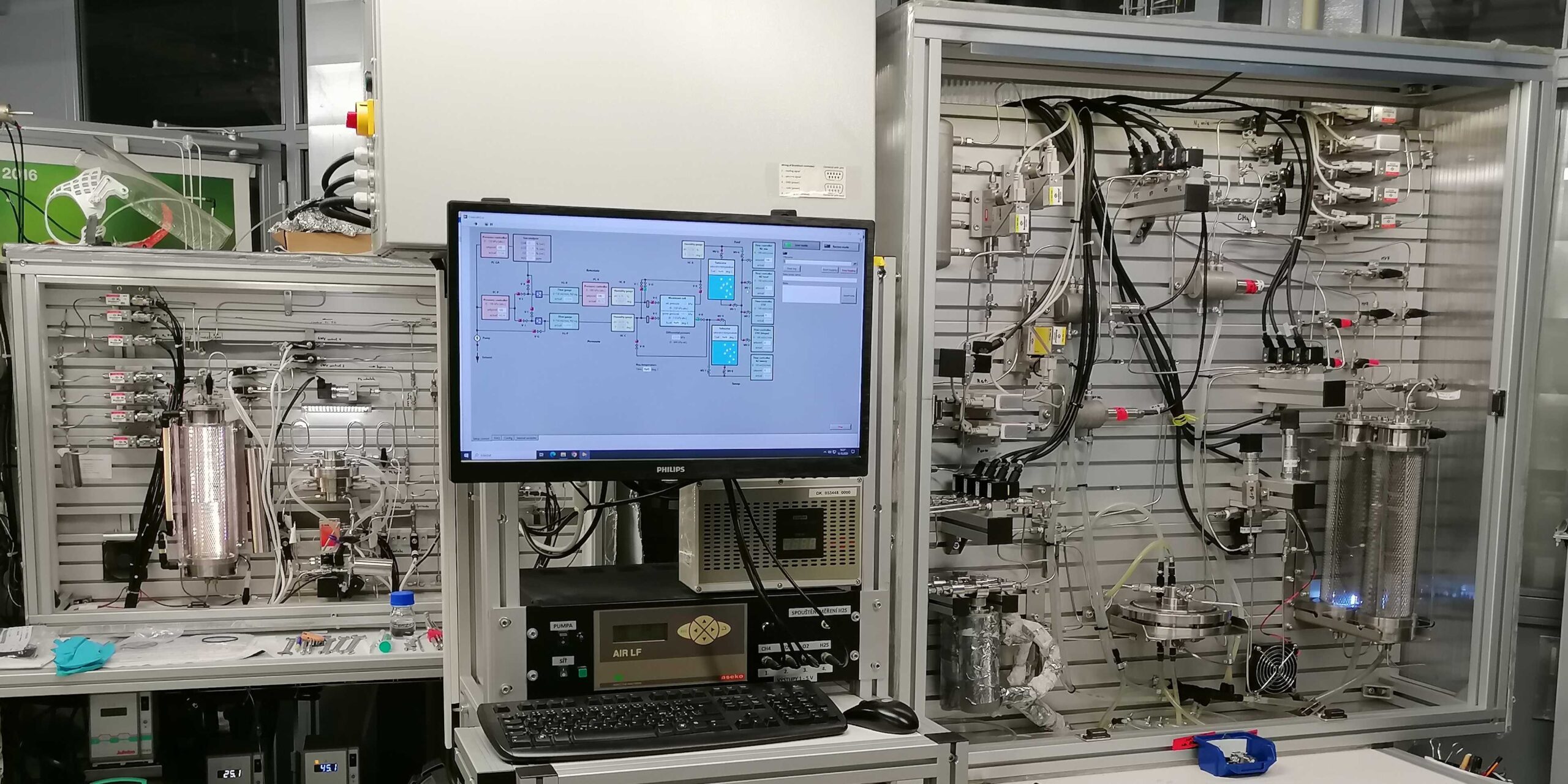 We focus on membrane separation of gas mixtures, especially the treatment of raw biogas from various sources to obtain an alternative fuel - CNG. With regard to the current trend of decarbonization of technologies, we also deal with the capture of carbon dioxide (CO2) and other gaseous pollutants from flue gases. Flue gas cleaning has great application potential for industry, especially with the increase in the price of emission allowances and new stricter emission limits. Gas separation is studied using both commercially available membranes and our own membranes, which are prepared in our laboratory or in cooperation with universities and research institutions in the Czech Republic or abroad.
We focus on membrane separation of gas mixtures, especially the treatment of raw biogas from various sources to obtain an alternative fuel - CNG. With regard to the current trend of decarbonization of technologies, we also deal with the capture of carbon dioxide (CO2) and other gaseous pollutants from flue gases. Flue gas cleaning has great application potential for industry, especially with the increase in the price of emission allowances and new stricter emission limits. Gas separation is studied using both commercially available membranes and our own membranes, which are prepared in our laboratory or in cooperation with universities and research institutions in the Czech Republic or abroad.
We study mainly polymer membranes with supported ionic liquids, polymers with intrinsic microporosity, or composite membranes with targeted surface treatment or modified by process conditions. The transport and separation properties of these membranes are evaluated from the experimental data to assess the prospective use of the studied materials as well as input information for models for the design of membrane modules and the separation process.
Separation of organic vapors from the air
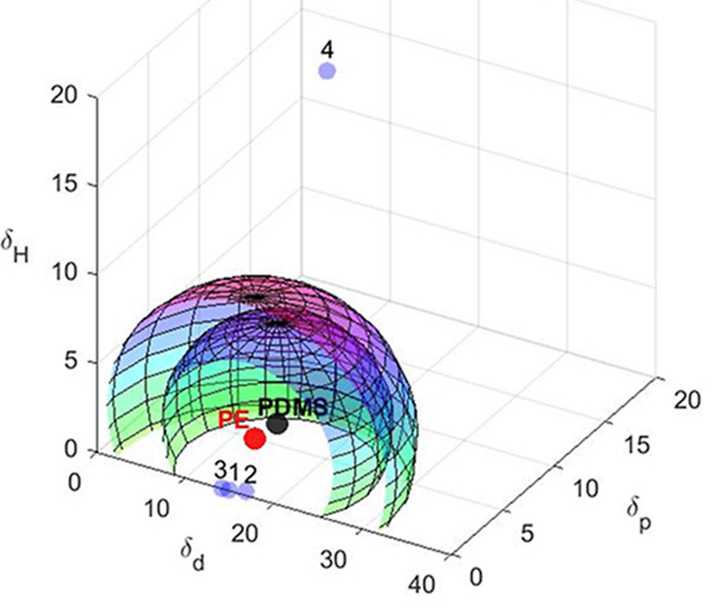
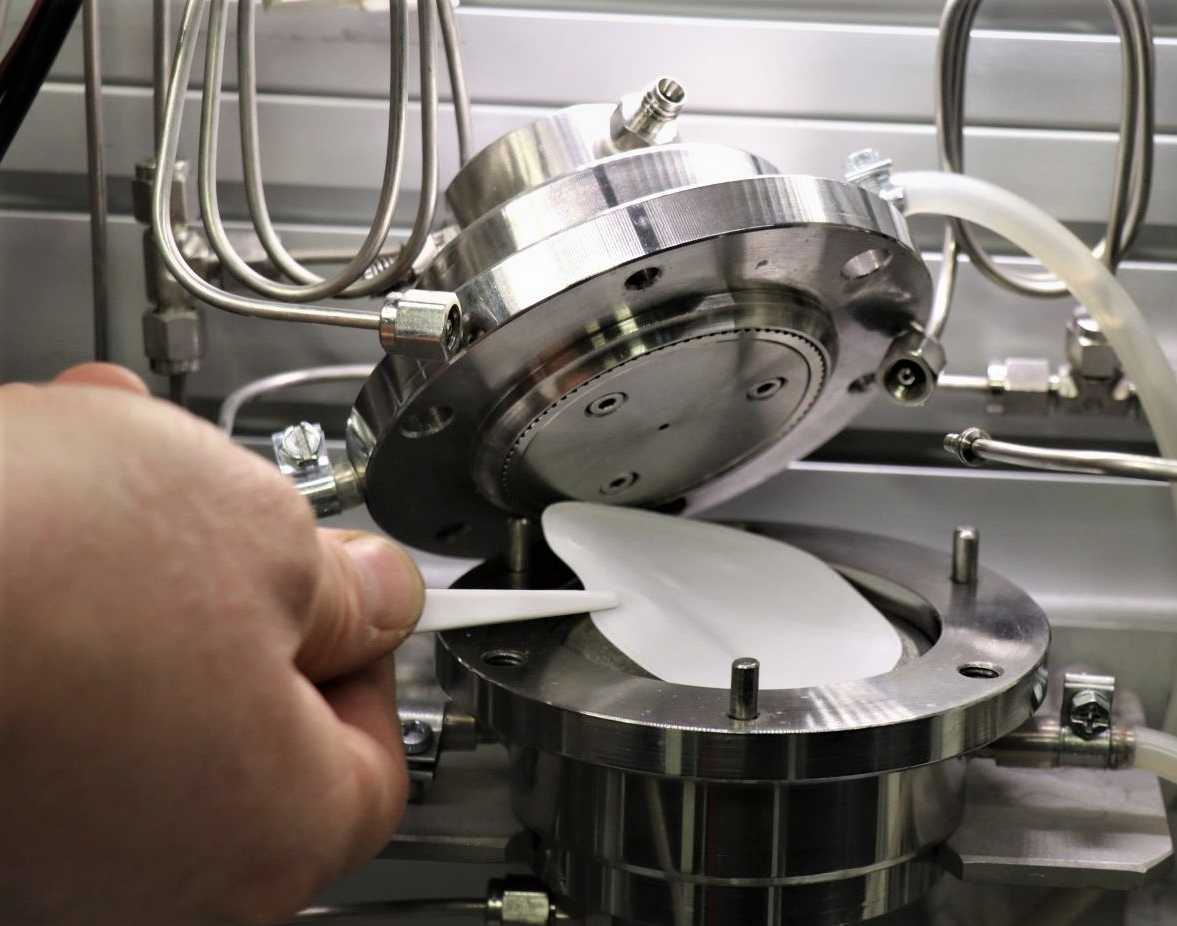 This area of research is focused on the study of the transport and separation properties of polymer and composite membranes for the capture of organic vapors from the air. We investigate the properties of the membranes under different inlet conditions, while the membranes are studied in long-term contact with organic substances since long-term stability is a key factor in the selection of a suitable material. Experiments are carried out on our own unique and fully automatic permeation apparatus, while our research covers the entire range of structurally different organic substances, which allows us to investigate different physicochemical models for describing the solubility of vapors, their transport, and interactions with polymers.
This area of research is focused on the study of the transport and separation properties of polymer and composite membranes for the capture of organic vapors from the air. We investigate the properties of the membranes under different inlet conditions, while the membranes are studied in long-term contact with organic substances since long-term stability is a key factor in the selection of a suitable material. Experiments are carried out on our own unique and fully automatic permeation apparatus, while our research covers the entire range of structurally different organic substances, which allows us to investigate different physicochemical models for describing the solubility of vapors, their transport, and interactions with polymers.
Separation of liquid mixtures
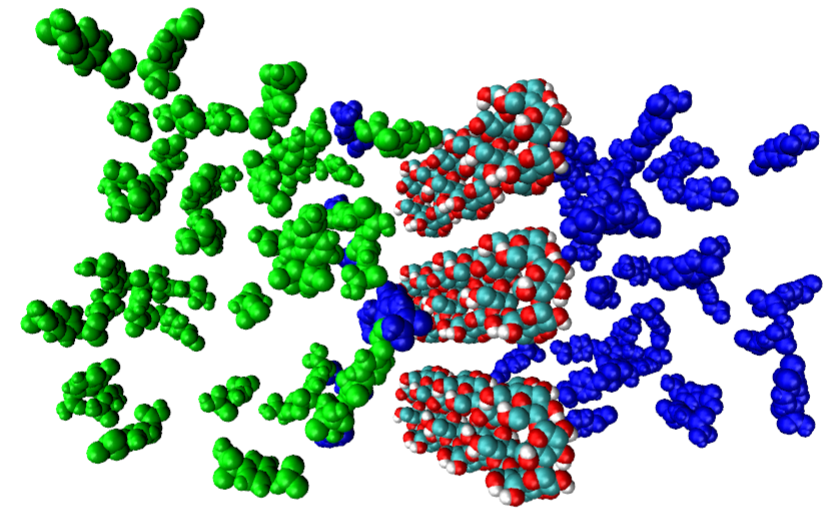
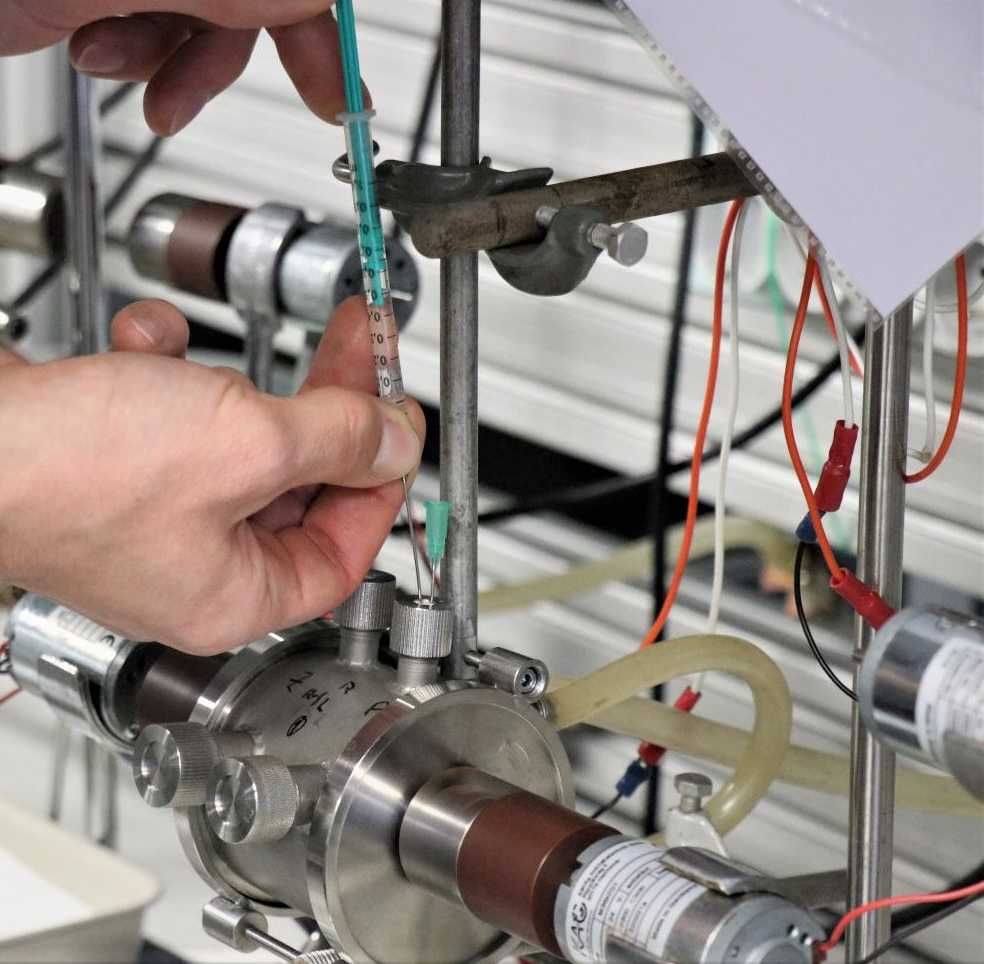 The study of the separation of liquid mixtures is carried out in unique "homemade" pervaporation and perstraction apparatuses. While pervaporation can separate various liquid mixtures, including azeotropic mixtures, the goal of perstraction experiments is to obtain an enantiomerically pure compound and capture various drugs from water. The research takes place on two levels, namely by experimental determination of transport and separation properties on membranes with suitable selectors, and at the same time theoretically, where modeling using molecular dynamics is directly used to understand the elementary steps of separation with the investigated selectors and the influence of other process parameters (polarity of solvents, pH, etc.).
The study of the separation of liquid mixtures is carried out in unique "homemade" pervaporation and perstraction apparatuses. While pervaporation can separate various liquid mixtures, including azeotropic mixtures, the goal of perstraction experiments is to obtain an enantiomerically pure compound and capture various drugs from water. The research takes place on two levels, namely by experimental determination of transport and separation properties on membranes with suitable selectors, and at the same time theoretically, where modeling using molecular dynamics is directly used to understand the elementary steps of separation with the investigated selectors and the influence of other process parameters (polarity of solvents, pH, etc.).
CO2 and SO2 removal from flue gas and waste streams
Recently, we reviewed the state of membrane separation in post-combustion CO2 capture, highlighting the potential of membrane technology despite challenges such as polymer aging and sensitivity to minor species (SO2, NOX, humidity). We experimentally explore various membrane compositions and configurations to achieve efficient gas separation of CO2 as well as SO2. For instance, we examine the separation performance of membranes blended with ionic liquids or using water-swollen composite membranes, observing increased permeability and selectivity. Furthermore, we assessed the potential of ultrapermeable membranes based on polymers of intrinsic microporosity for SO2 and CO2 removal in complex gas mixtures resembling industrial conditions. Additionally, membrane technologies were reviewed for their potential in simultaneous chemical transformations combining separation catalytic processes.
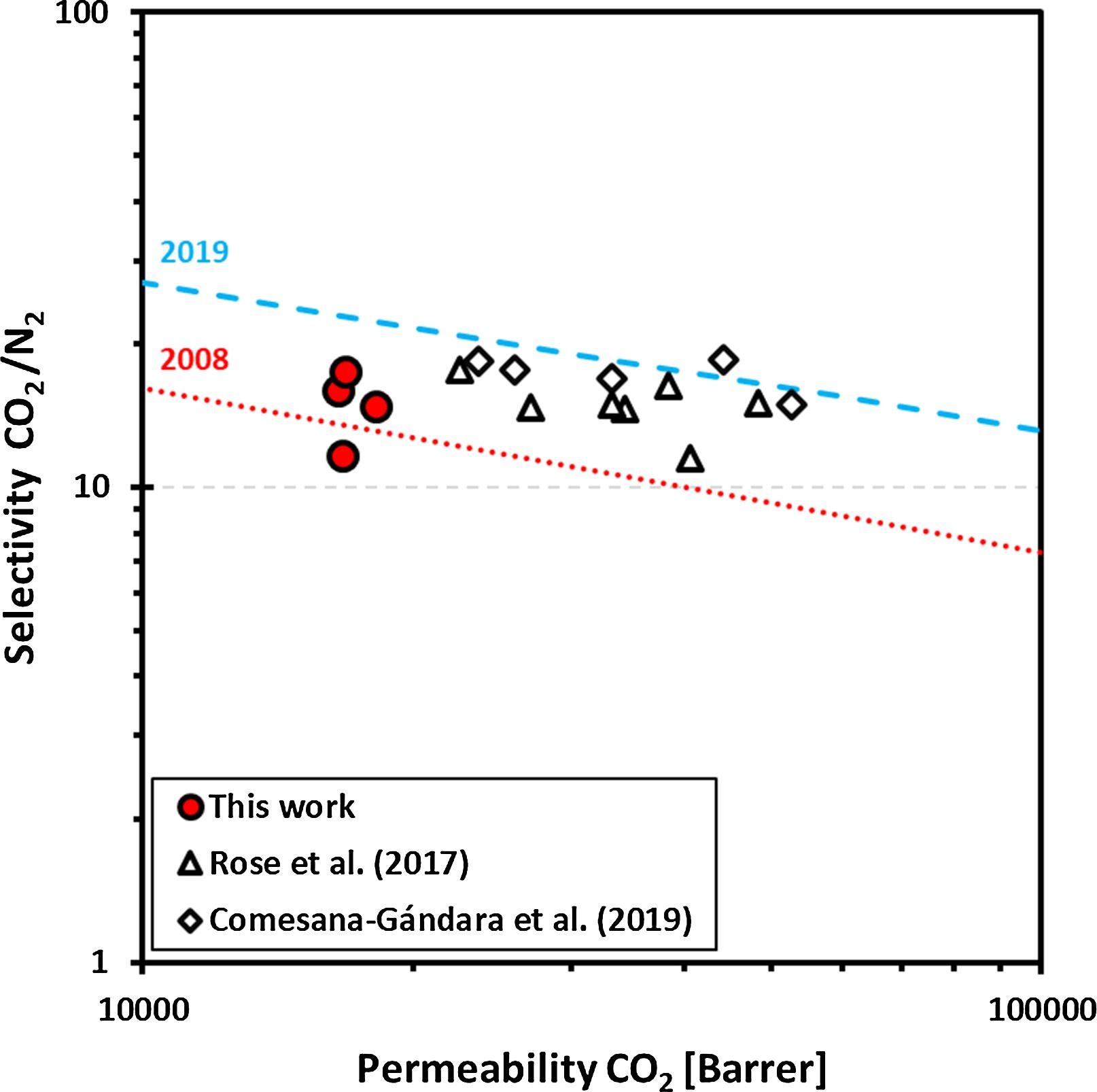 |
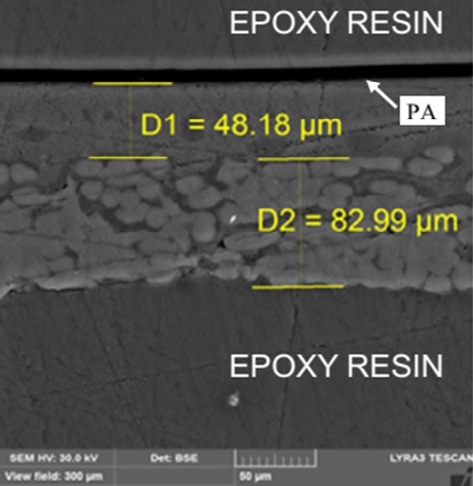 |
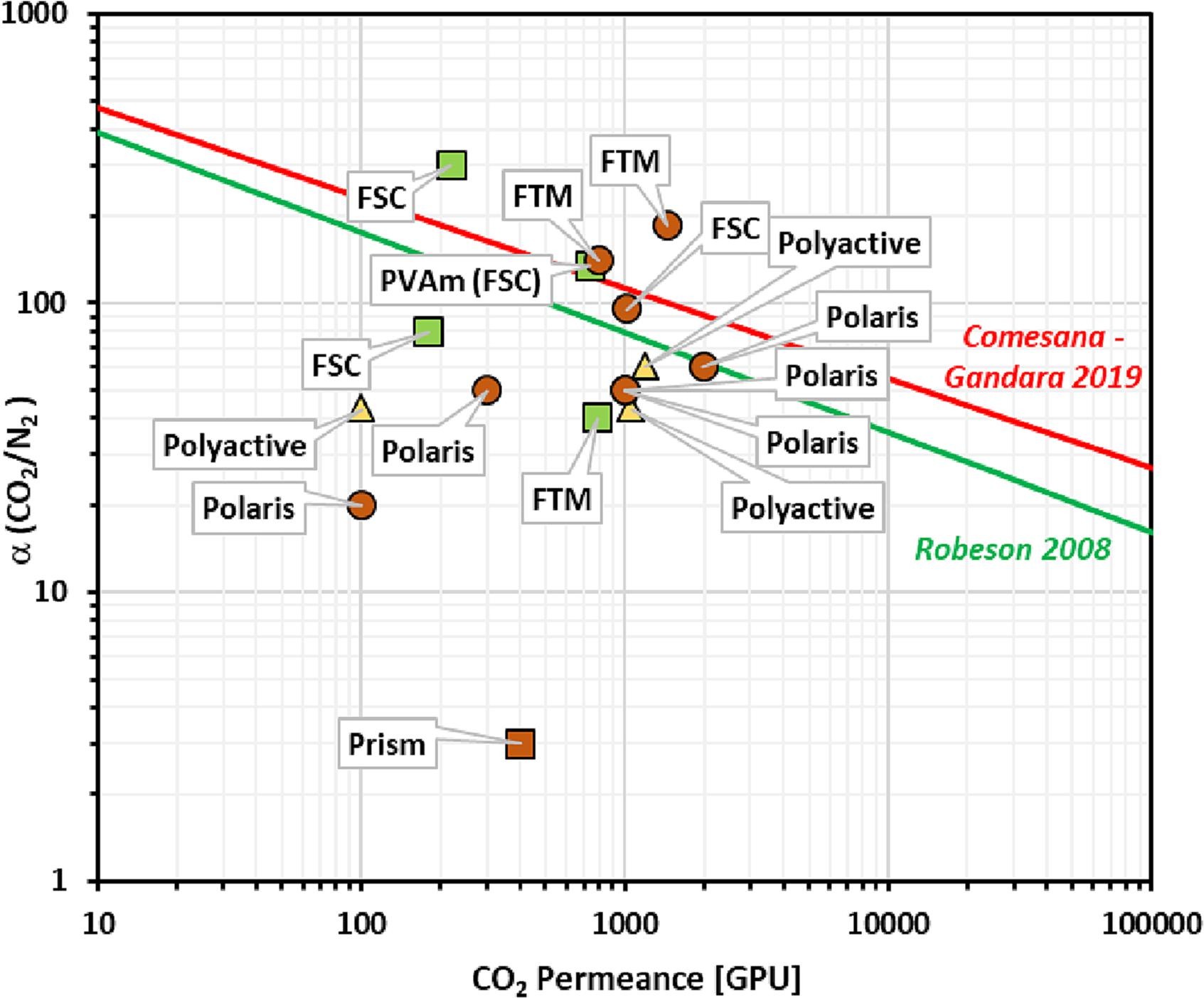 |
The trade-off for CO2/N2 for PIM-TMN-Trip membrane with different ages or processing. SEM of the Thin Film Composite membrane used for water-swollen study. Membrane modules tested for flue gas purification at large installations
- Pasichnyk M., Stanovsky P., Polezhaev P., Zach B., Syc M., Bobák M., Jansen J.C., Pribyl M., Bara J.E., Friess K., Havlica J., Gin D.L., Noble R.D., Izák P.: Membrane technology for challenging separations: Removal of CO2, SO2 and NOx from flue and waste gases. Sep. Purif. Technol. 323(15 Oct), 124436, 2023. DOI
- Klepic M., Jansen J.C., Fuoco A., Esposito E., Izak P., Petrusova Z., Vankelecom I.F.J., Randova A., Fila V., Lanc M., Friess K.: Gas separation performance of carbon dioxide-selective poly(vinyl alcohol)-ionic liquid blend membranes: The effect of temperature, feed pressure and humidity. Sep. Purif. Technol. 270(1 Sep), 118812 2021. DOI
- Stanovsky P., Zitkova A., Karaszova M., Syc M., Jansen J.C., Gandara B.C., McKeown N., Izak P.: Flue gas purification with membranes based on the polymer of intrinsic microporosity PIM-TMN-Trip. Sep. Purif. Technol. 242(1 Jul), 116814, 2020. DOI
- Karaszova M., Zach B., Petrusova Z., Cervenka V., Bobak M., Syc M., Izak P.: Post-combustion carbon capture by membrane separation, Review. Sep. Purif. Technol. 238(1 May), 116448, 2020. DOI
- Klepic M., Fuoco A., Monteleone M., Esposito E., Friess K., Petrusova Z., Izak P., Jansen J.C.: Tailoring the Thermal and Mechanical Properties of PolyActive Poly(Ether-Ester) Multiblock Copolymers Via Blending with CO2-Phylic Ionic Liquid. Polymers 12(4), 890, 2020. DOI
- Klepic M., Setnickova K., Lanc M., Zak M., Izak P., Dendisova M., Fuoco A., Jansen J.C., Friess K.: Permeation and sorption properties of CO2-selective blend membranes based on polyvinyl alcohol (PVA) and 1-ethyl-3-methylimidazolium dicyanamide ([EMIM] [DCA]) ionic liquid for effective CO2/H2 separation. J. Membr. Sci. 597(1 Mar), 117623, 2020. DOI
- Žitková A., Kárászová M., Stanovský P., Vejražka J., Izák P.: Application of Water‐Swollen Thin‐Film Composite Membrane in Flue Gas Purification. Chem. Eng. Technol. 42(6), 1304-1309, 2019. DOI
- Izak P., Bobbink F.D., Hulla M., Klepic M., Friess K., Hovorka S., Dyson P.J.: Catalytic Ionic-Liquid Membranes: The Convergence of Ionic-Liquid Catalysis and Ionic-Liquid Membrane Separation Technologies. ChemPlusChem 83(1), 7-18, 2018. DOI
Upgrading of raw biogas to CNG quality
We explore innovative methods for upgrading biogas to CNG quality using various membrane technologies. Primarily, we investigate the incorporation of ionic liquids into polymer membranes on CO2/CH4 separation and we utilize molecular dynamics simulation to understand the interplay of gas sorption and permeation in gas mixtures. Additionally, we evaluate the performance of either mixed matrix membranes with functional fillers as graphene oxide/metal-organic framework or ultrapermeable polymers of intrinsic microporosity, demonstrating significant improvements in CO2 permeability while maintaining good performance stability in gas mixtures. Finally, we explore the effectiveness of water-swollen composite membranes for separating CH4 from other raw biogas species, achieving high methane recovery ratios and efficient desulfurization.
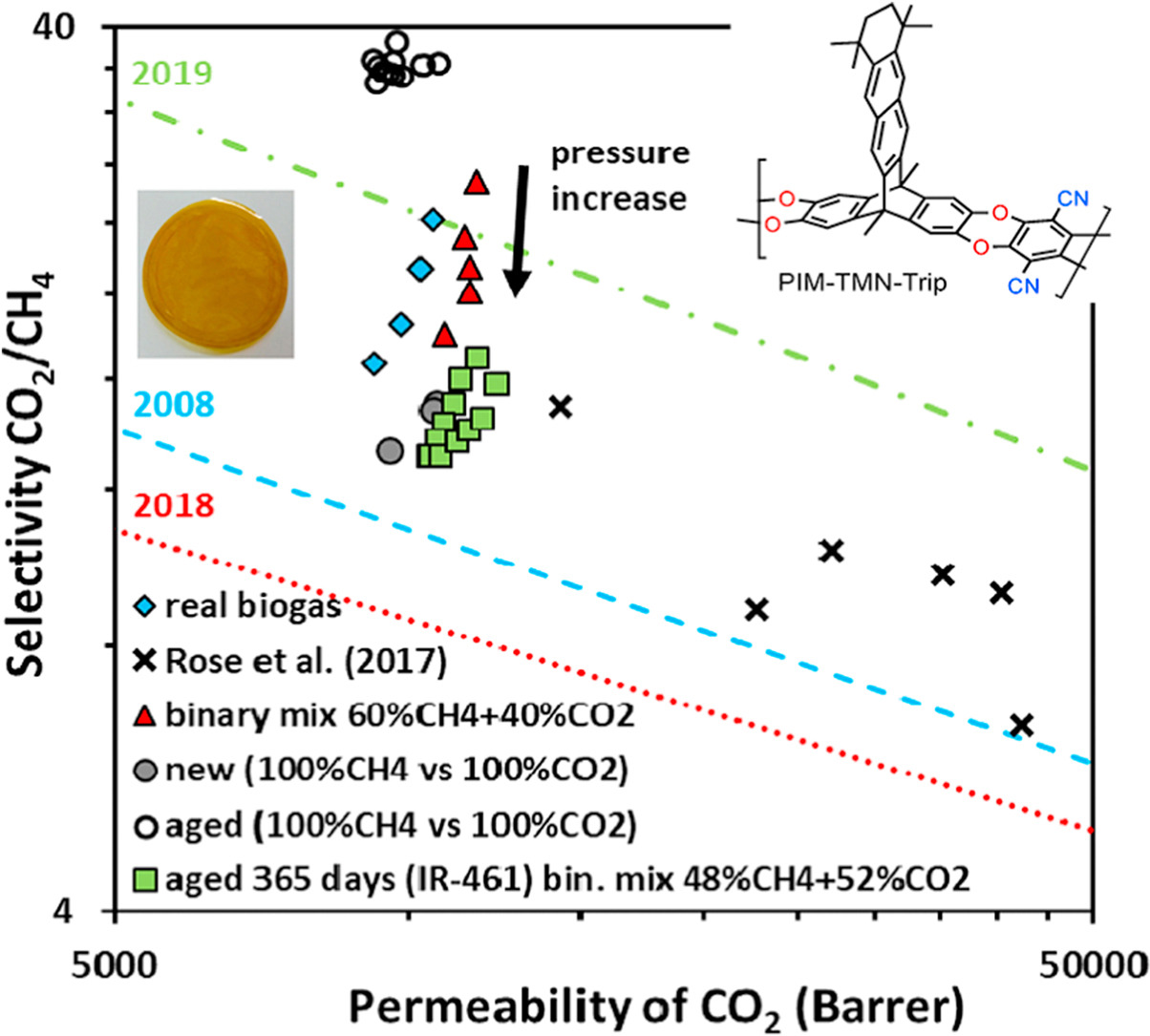 |
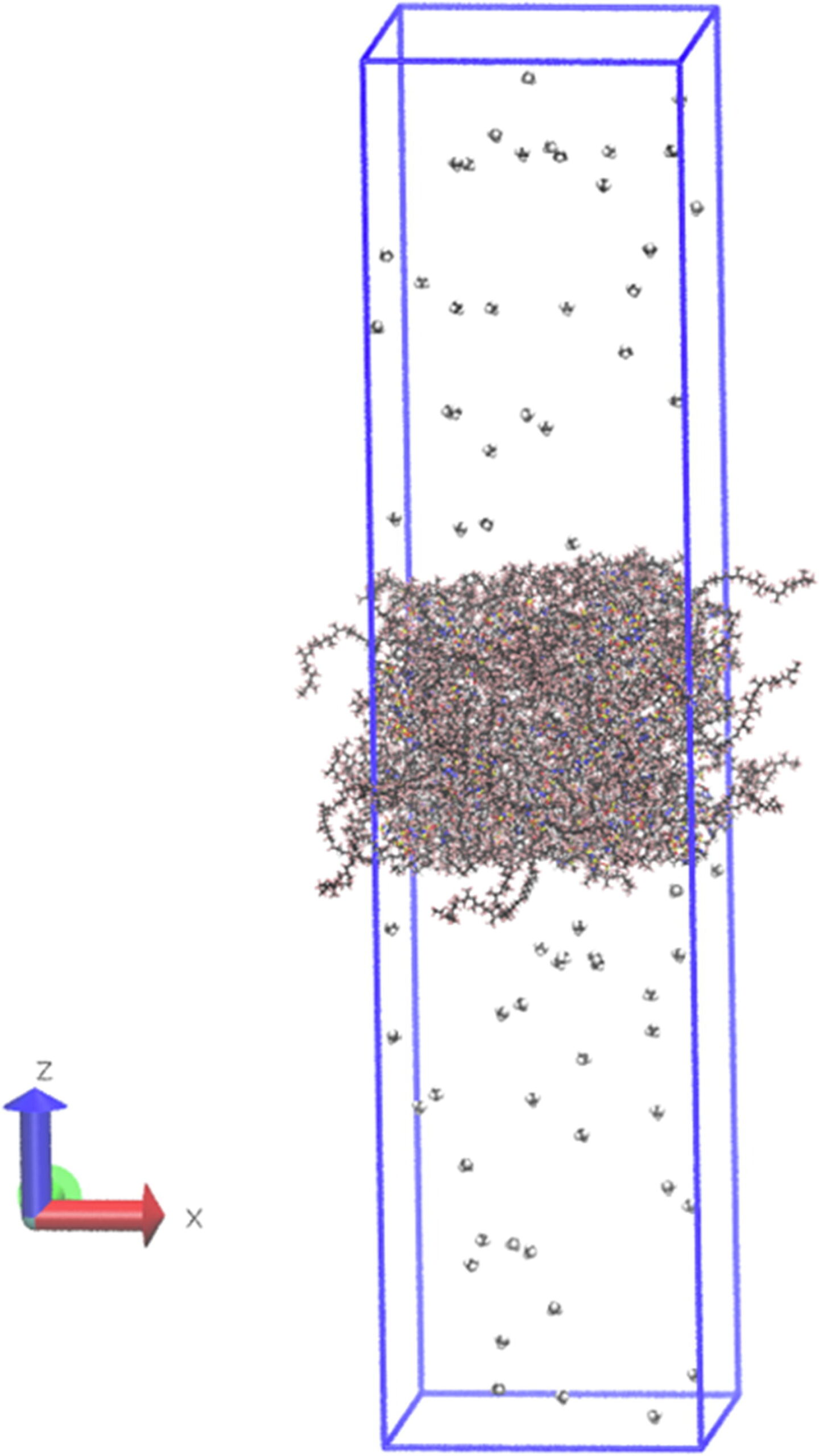 |
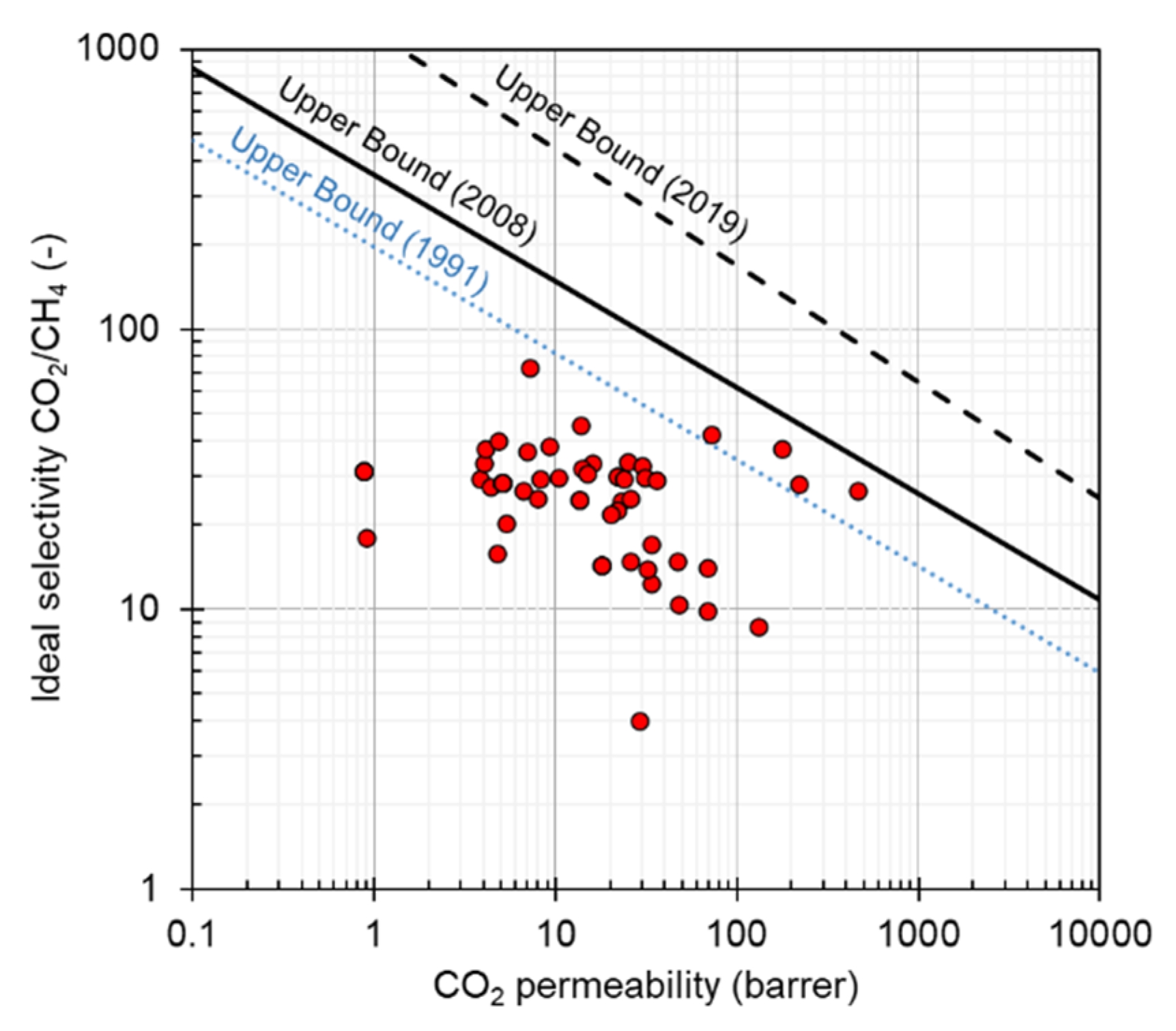 |
Trade-off diagram CO2/CH4 for PIM-TMN-Trip membrane for pure gases and gas mixtures. MD model for 10-mer with 20 wt.% ionic liquid and mixture CO2+CH4. Trade-off diagram CO2/CH4 for poly(ionicliquids)
- Wojnarova P., Rusin J., Basinas P., Kostejn M., Nemec J., Stanovský P., Kim A. S., Izak P.: Unveiling the potential of composite water-swollen spiral wound membrane for design of low-cost raw biogas purification. Sep. Purif. Technol. 326(1 Dec), 124783, 2023. DOI
- Stanovský P., Benkocká M, Kolská Z., Šimčík M., Slepička P., Švorčík V., Friess K., Ruzicka M.C., Izak P.: Permeability enhancement of chemically modified and grafted polyamide layer of thin-film composite membranes for biogas upgrading. J. Membr. Sci. 641(1 Jan), 119890, 2022. DOI
- Jung A., Reha D., Minofar B., Stanovsky P., Pasichnyk M., Pribyl M., Bara J. E., Friess K., Fila V., Izak P.: Molecular simulation of poly(VDF-HFP) copolymer with imidazolium-based ionic liquid as an effective medium for biogas separation. J. Mol. Liq. 366(15 Nov), 120287, 2022. DOI
- Stanovsky P., Karaszova M., Petrusova Z., Monteleone M., Jansen J.C., Comesana-Gandara B., McKeown N.B., Izak P.: Upgrading of raw biogas using membranes based on the ultrapermeable polymer of intrinsic microporosity PIM-TMN-Trip. J. Membr. Sci. 618(15 Jan), 118694, 2021. DOI
- Friess K., Izak P., Karaszova M., Pasichnyk M., Lanc M., Nikolaeva D., Luis P., Jansen J.C.: A Review on Ionic Liquid Gas Separation Membranes. Membranes 11(2), 97, 2021. DOI
- Levdansky V., Solcova O., Friess K., Izak P.: Mass Transfer Through Graphene-Based Membranes. Appl. Sci. 10(2), 455, 2020. DOI
- Zak M., Bendova H., Friess K., Bara J.E., Izak P.: Single-step purification of raw biogas to biomethane quality by hollow fiber membranes without any pretreatment-An innovation in biogas upgrading. Sep. Purif. Technol. 203(12 Sep), 36-40, 2018. DOI
Membrane separation of enantiomers
We investigated various approaches to enhance chiral recognition and selectivity of polymers for membrane-based enantioseparation. Our recent advances include blending polymers with different ionic liquids to improve chiral recognition by tuning the polymer structure, optimizing membrane preparations and conditions of enantioseparation process for new synthesized optically active linear polyimides and hyperbranched poly(amic acid–imide). We also tested and optimized ionically bound cyclodextrin derivatives to Nafion®, where membranes showed great potential for electrostatic binding and enantioseparation of chiral drugs. Furthermore, we reviewed the progress in microfluidics and micromembrane separations, highlighting their potential for the continuous production of pure enantiomers. Theoretical analysis of lateral electrochromatography offers an insight into operational parameters necessary for efficient separation of enantiomers in the presence of the electric field. The molecular dynamics simulations are regularly employed to answer the interplay of molecular structures of the solvent/chiral selector/target chiral molecule.
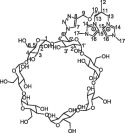 |
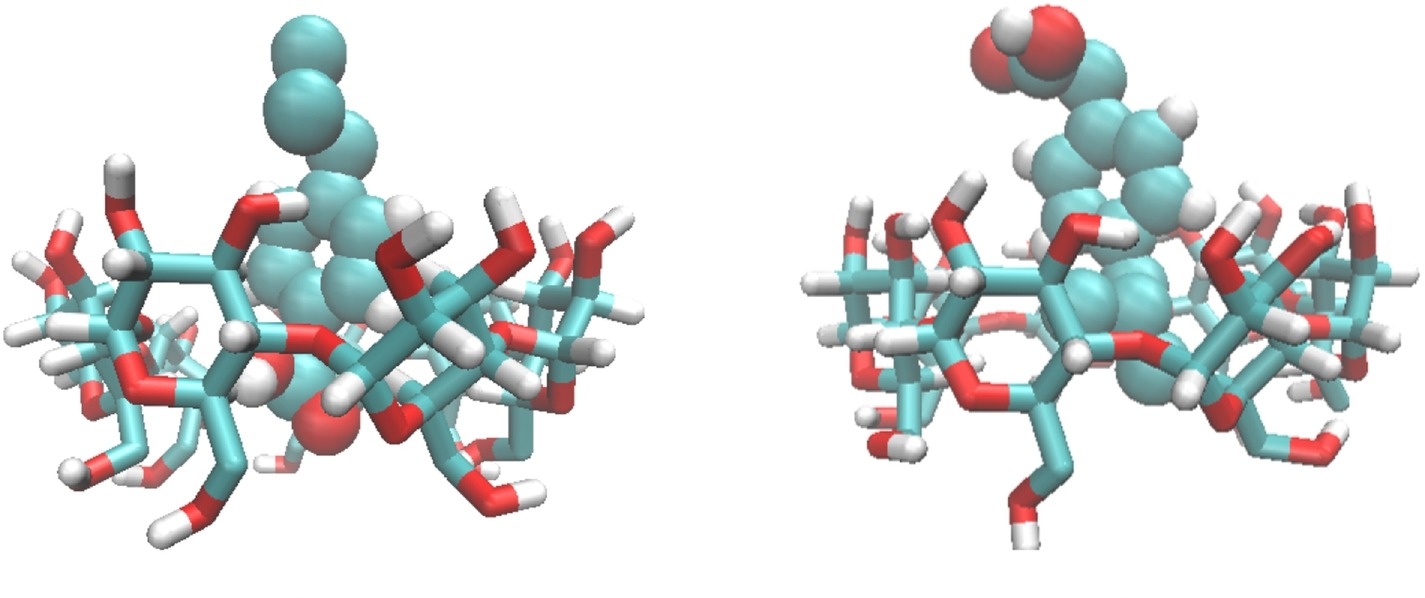 |
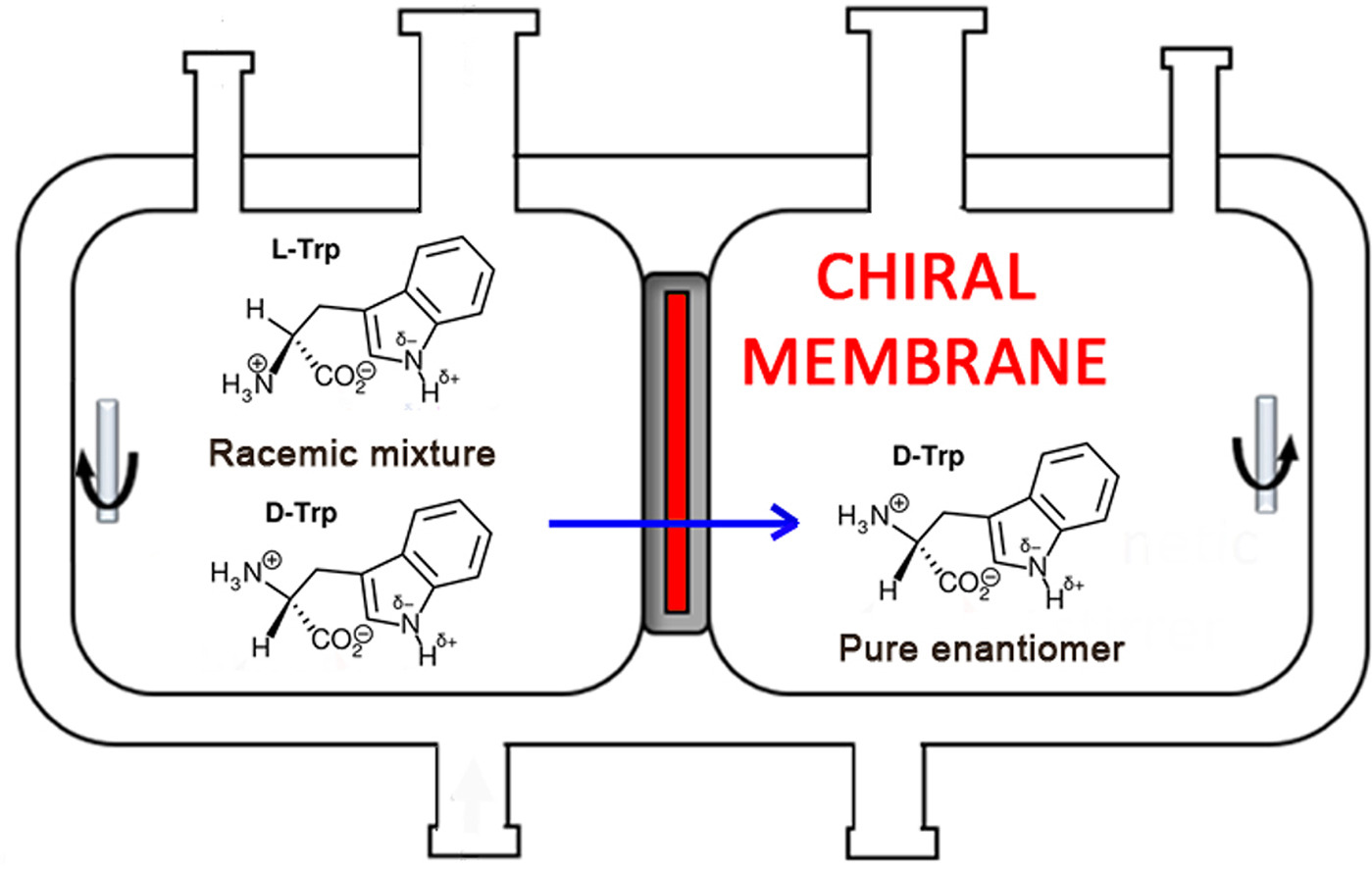 |
Chiral selector β-cyclodextrin containing spacer modifying binding site to Nafion. Variable topology of complexes of β-cyclodextrin and (R)-ibuprofen. Scheme of pertraction cell for enantioseparation
- Hovorka Š., Hrdlička Z., Jeništová A., Švecová M., Izák P., Čížek J., Michalcová A., Hadravová R., Vopička O.: Impacts of ions on the plasticization of cellulose triacetate by fluorinated ionic liquids: Thermal properties, microscopy, Raman spectra, and sorption of pure enantiomers. Polymer 290(5 Jan), 126502, 2024. DOI
- Sysel P., Holakovský R., Hovorka Š., Žádný J., Izák P.: Preparation of Optically Active Polyimides Based on 2,2´-diamino-1,1´-binaphthalene. J. Polym. Mater. 39(3-4), 325-335, 2023. DOI
- Petrusova Z., Slouka Z., Vobecka L., Polezhaev P., Hasal P., Pribyl M., Izak P.: Microreaction and membrane technologies for continuous single-enantiomer production: A review. Cat. Rev. 65(3), 773-821, 2023. DOI
- Sysel P., Hovorka S., Kohout M., Holakovsky R., Zadny J., Cizek J., Izak P.: Optically active polyimides with different thermal histories of their preparation. Chirality 34(8), 1151-1161, 2022. DOI
- Přibyl M., Izák P., Slouka Z.: A mathematical model of a lateral electrochromatography device for continuous chiral separation. Sep. Purif. Technol. 282(1 Feb), 120033, 2022. DOI
- Hercikova J., Spalovska D., Fruhauf P., Izak P., Lindner W., Kohout M.: Design and synthesis of naphthalene-based chiral strong cation exchangers and their application for chiral separation of basic drugs. J. Sep. Sci. 44(18), 3348-3356, 2021. DOI
- Kasal P., Michel M., Gaalova J., Curinova P., Izak P., Dian J., Jindrich J.: Chiral Nafion membranes prepared by strong electrostatic binding of multiply positively charged beta-cyclodextrin derivatives for tryptophan racemic mixtures' separation. Mater. Today Commun. 27(Jun), 102234, 2021. DOI
- Gaalova J., Michel M., Bourassi M., Ladewig B. P., Kasal P., Jindrich J., Izak P.: Nafion membranes modified by cationic cyclodextrin derivatives for enantioselective separation. Sep. Purif. Technol. 266(1 Jul), 118538, 2021. DOI
- Brozova L., Zazpe R., Otmar M., Prikryl J., Bulanek R., Zitka J., Krejcikova S., Izak P., Macak J. M.: Chiral Templating of Polycarbonate Membranes by Pinene Using the Modified Atomic Layer Deposition Approach. Langmuir 36(42), 12723-12734, 2020. DOI
- Skvara J., Nezbeda I., Izak P.: Molecular dynamics study of racemic mixtures. II. Temperature dependence of the separation of ibuprofen racemic mixture with beta-cyclodextrin in methanol solvent. J. Mol. Liq. 302(15 Mar), 112575, 2020. DOI
- Nezbeda I., Škvára J.: On industrial applications of molecular simulations. Mol. Simul. 47(10-11), 846-856, 2020. DOI
- Gaalova J., Yalcinkaya F., Curinova P., Kohout M., Yalcinkaya B., Kostejn M., Jirsak J., Stibor I., Bara J. E., Van der Bruggen B., Izák P.: Separation of racemic compound by nanofibrous composite membranes with chiral selector. J. Membr. Sci. 596(15 Feb), 117728, 2020. DOI
- Otmar M., Gaalova J., Zitka J., Brozova L., Curinova P., Kohout M., Hovorka S., Bara J. E., Van der Bruggen B., Jirsak J., Izák P.: Preparation of PSEBS membranes bearing (S)-(-)-methylbenzylamine as chiral selector. Eur. Polym. J. 122(5 Jan), 109381, 2020. DOI
- Kohout M., Hovorka S., Hercikova J., Wilk M., Sysel P., Izak P., Bartunek V., von Baeckmann C., Picha J., Fruhauf P.: Evaluation of silica from different vendors as the solid support of anion-exchange chiral stationary phases by means of preferential sorption and liquid chromatography. J. Sep. Sci. 42(24), 3653-3661, 2019. DOI
- Škvára J., Nezbeda I.: Molecular dynamics study of racemic mixtures: Solutions of ibuprofen and β-cyclodextrin in methanol. J. Mol. Liq. 265(1 Sep), 791-796, 2018. DOI
- Curinova P., Dracinsky M., Jakubec M., Tlusty M., Janku K., Izak P., Holakovsky R.: Enantioselective complexation of 1-phenylethanol with chiral compounds bearing urea moiety. Chirality 30(6), 798-806, 2018. DOI
Removal of emerging contaminants from water with membranes
Our research on emerging contaminants addresses their removal of from water using membrane technology. We reviewed different membrane materials, comparing those that separate based on particle size with dense hydrophobic membranes designed for targeted removal of certain classes of contaminants. In our studies, cutting-edge materials such as hydrophilic and hydrophobic single-walled carbon nanotube membranes were tested for eliminating antibiotics with promising filtration and sorption results. Additionally, we investigated the use of PDMS membranes for separating antibiotic mixtures, observing their complex co-elution but we improved membrane selectivity to certain antibiotics by surface modification. Furthermore, we developed polymer-ZnO nanocomposite membranes to effectively remove organic dyes prevalent in various industries.
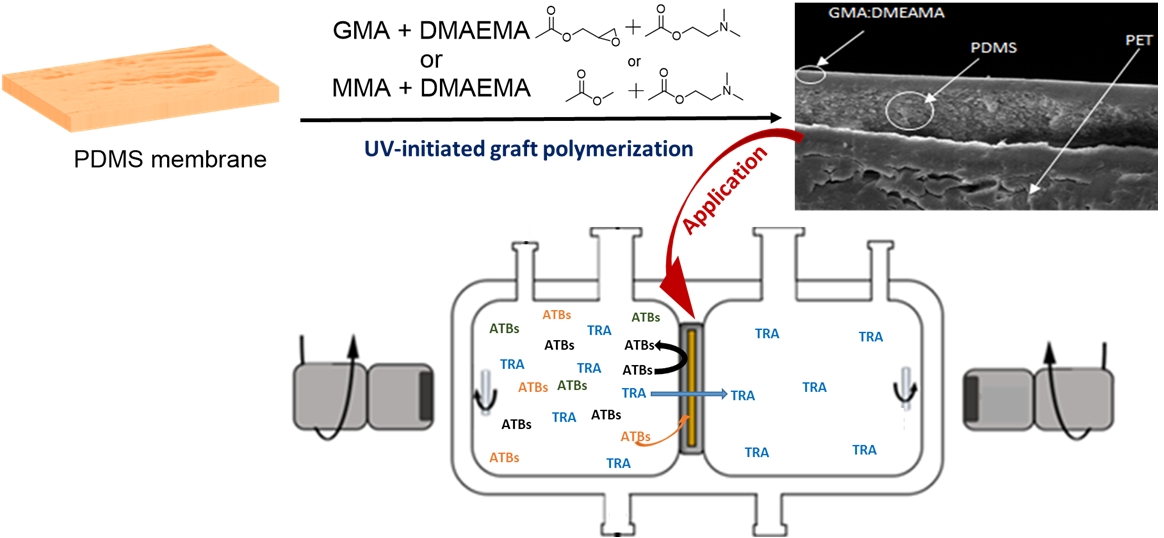 |
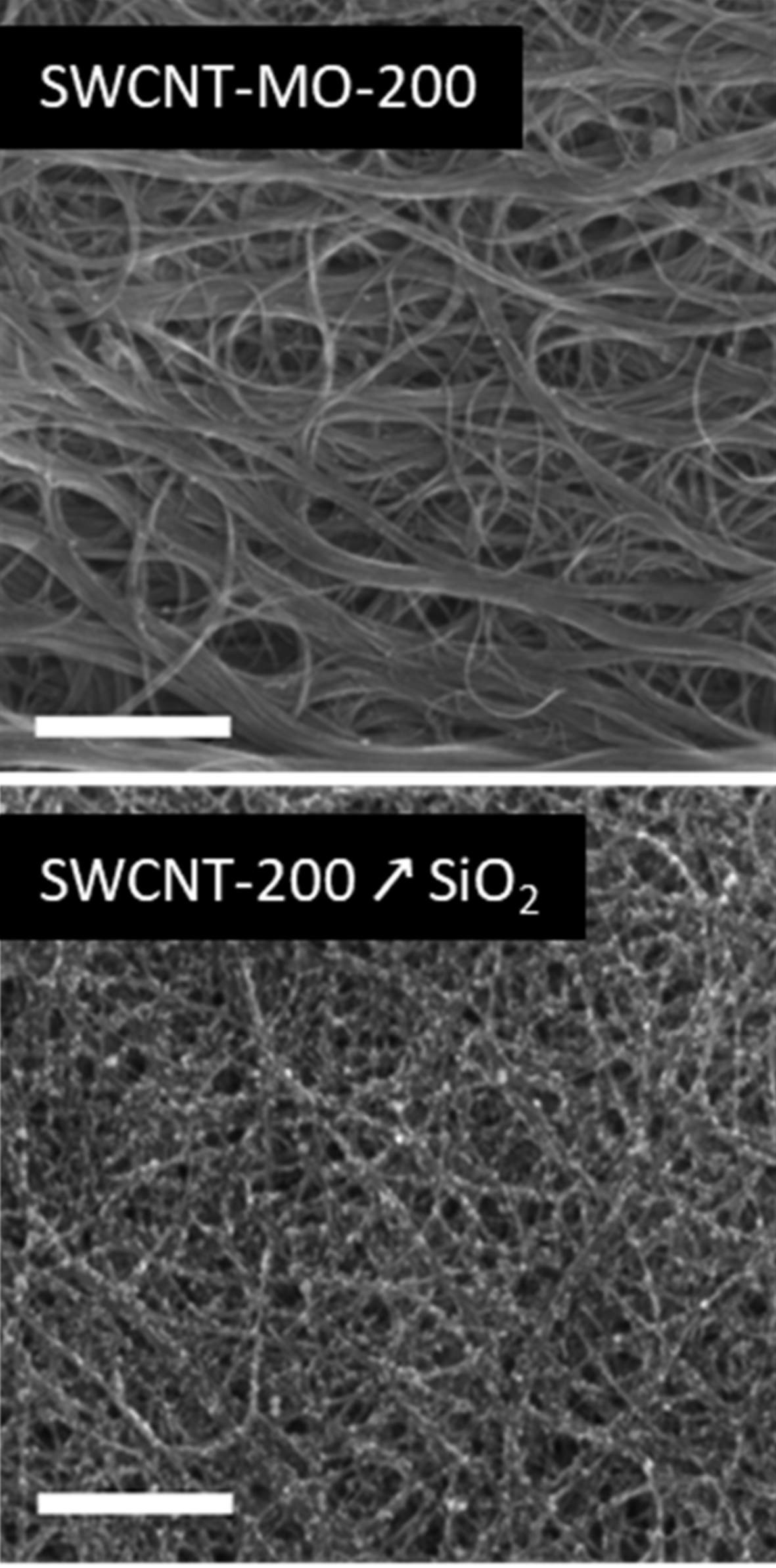 |
UV grafting of polydimethylsiloxane membranes for tramadol separation via pertraction. SEM of original carbon nanotubes and with SiO2 nanoparticles deposited on their surface
- Pasichnyk M., Gaalova J., Minarik P., Vaclavikova M., Melnyk I.: Development of polyester filters with polymer nanocomposite active layer for effective dye filtration. Sci. Rep. 12(1), 973, 2022. DOI
- Bourassi M., Pasichnyk M., Oesch O., Sundararajan S., Travnickova T., Soukup K., Kasher R,; Gaalova J.: Glycidyl and Methyl Methacrylate UV-Grafted PDMS Membrane Modification toward Tramadol Membrane Selectivity. Membranes 11(10), 752, 2021. DOI
- Gaalova J., Bourassi M., Soukup K., Travnickova T., Bousa D., Sundararajan S., Losada O., Kasher R., Friess K., Sofer Z.: Modified Single-Walled Carbon Nanotube Membranes for the Elimination of Antibiotics from Water. Membranes 11(9), 720, 2021. DOI
- Karaszova M., Bourassi M., Gaalova J.: Membrane Removal of Emerging Contaminants from Water: Which Kind of Membranes Should We Use? Membranes 10(11), 305, 2020. DOI
Separation of organic compounds from mixtures by vapor permeation or pervaporation
We reviewed various membrane materials for vapor permeation of volatile organic compounds highlighting the scarcity of information on binary VOC/N2 mixtures and rare examination of multicomponent mixtures. Our experimental and theoretical research focus on the applicability of solubility parameters in predicting VOC/N2 separation efficiency, scoring best with Hansen solubility parameters for VOCs with limitations for cyclic hydrocarbons. We resolved the aging of thin film composite membranes exposed to alkane vapors facilitating conventional solvent exchange drying for membrane regeneration. Furthermore, we identified the primary contributors to errors in vapor permeability measurement, emphasizing the importance of optimizing operational parameters to reduce theoretical errors, beneficial for low-permeable membranes.
Vapor permeability of structurally different VOCs vs their activity in the feed including the particular Hansen solubility parameter 3D plot
- Jirsakova K., Stanovsky P., Dytrych P., Moravkova L., Pribylova K., Petrusova Z., Jansen J. C., Izak P.: Organic vapour permeation in amorphous and semi-crystalline rubbery membranes: Experimental data versus prediction by solubility parameters. J. Membr. Sci. 627(1 Jun), 119211, 2021. DOI
- Petrusová Z., Morávková L., Stanovský P., Machanová K., Koštejn M., Jandová V., Izák P.: Regeneration of thin-film composite membrane used for permeation of hexane vapors. Sep. Purif. Technol. 224(1 Oct), 62-69, 2019. DOI
- Petrusova Z., Machanova K., Stanovsky P., Izak P.: Separation of organic compounds from gaseous mixtures by vapor permeation. Sep. Purif. Technol. 217(15 Jun), 95-107, 2019. DOI
- Dytrych P., Vajglová Z., Morávková L., Jandová V., Izák P., Petrusová Z.: Minimization of the Theoretical Error of Input Parameters for a Vapor Permeation Apparatus Chem. Eng. Technol. 41(9), 1727-1736, 2018. DOI
Our research explored the application of pervaporation for separating organic compounds from mixtures. We successfully utilize pervaporation in conjunction with a Ru-BINAP chiral catalytic complex, avoiding catalyst sorption into the membrane and employing an ionic liquid/methanol phase as a green solvent for the reaction. Further, we successfully utilize the pervaporation of an azeotropic mixture with trimethyl borate, a precursor to boronic acids used in Suzuki couplings, using commercial membranes. Finally, our testing showed the potential for dealcoholizing beer using pervaporation with commercially available Sulzer membranes.
- Gaalova J., Hejda S., Stavarek P., Sykora J., Fajgar R., Kluson P., Izak P.: Pervaporation of (R)/(S)-methyl 3-hydroxybutyrate (Sigma MHB) from a mixture containing an ionic liquid, methanol and Ru catalyst. Sep. Purif. Technol. 222(1 Sep), 45-52, 2019. DOI
- Gaalova J., Vojtek L., Lasnier S., Tadic T., Sykora J., Izak P.: Separation of Trimethyl Borate from a Liquid Mixture by Pervaporation. Chem. Eng. Technol. 42(4), 769-773, 2019. DOI
- Halama R., Broz P., Izak P., Kacirkova M., Dienstbier M., Olsovska J.: Beer dealcoholization using pervaporation. Kvasny Prumysl 65(2), 65-71, 2019. DOI
